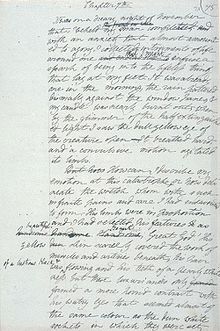Villa Diodati

The Villa Diodati is a mansion in the village of
, by Polidori.Origin
Originally called the "Villa Belle Rive", Byron named it the Villa Diodati after the family that owned it. The family was distantly related to Italian translator Giovanni Diodati, uncle of Charles Diodati, the close friend of poet John Milton. Despite the presence of a plaque at the Villa heralding a supposed visit of Milton in 1638, in fact the villa was not built until 1710, long after Milton's death.[1]
Summer of 1816

The weather was unseasonably cold and stormy, and Mary Shelley later described the "incessant rain" of that "wet, ungenial summer".[6][note 1] When the rain kept them indoors at the Villa Diodati over three days in June, the five turned to reading fantastical stories, including Fantasmagoriana, and then devising their own tales. Mary Shelley wrote the first draft of what would become Frankenstein, or The Modern Prometheus, she was just 18 years old at the time. Polidori was inspired by a fragmentary story of Byron's, Fragment of a Novel, to produce The Vampyre, the progenitor of the Romantic vampire genre.[8][9]

Byron's story fragment was published as a postscript to Mazeppa; he also wrote the third canto of Childe Harold.
Subsequent history
After Byron's death, the Villa Diodati soon became a place of pilgrimage for devotees of Byron, and of
The villa has remained in private ownership. In 1945, the French artist
Gallery
Notes
- ^ The storms and unseasonably cold weather resulted in 1816 being referred to as the Year Without a Summer. It is now known that the exceptional global weather conditions that year were caused by the volcanic eruption of Mount Tambora in Indonesia.[7]
References
- ^ "Milton and the Villa Diodati", William S. Clark, Review of English Studies, 1935:os-XI: 51-57.
- ISBN 978-0-7425-1162-0.
- ^ Jerome McGann, "Byron, George Gordon Noel, sixth Baron Byron", Oxford Dictionary of National Biography
- ISBN 0-8018-4218-2.
- ^ New York Times. 27 May 2011. Retrieved 2 November 2014.
- ^ Mary Shelley, paragraph 6, introduction to the 1831 edition of Frankenstein
- ISBN 0-8018-4218-2.
- ISBN 0-8018-4218-2.
- ^ Rigby, Mair. "'Prey to some cureless disquiet': Polidori's Queer Vampyre at the Margins of Romanticism". Paragraph 2. Romanticism on the Net, 36–37, November 2004. http://www.erudit.org/revue/RON/2004/v/n36-37/011135ar.html
- ISBN 978-0-8264-6844-4.
- ISBN 978-84-343-1165-7.
- ^ "Missed Opportunity". The Spectator. 8 November 2003. Retrieved 2 November 2014.









